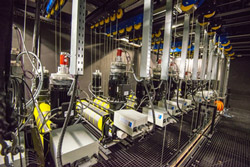
Posted to News on 21st Jun 2017, 16:28
Five factors to consider when specifying automation
Mark Turner, Applications Manager at Lenze, explains five factors that machine builders need to consider when making choices about technologies, as the implications can be considerable over the full lifecycle of a machine.

Motors, actuators and control systems are the frontline workers of advanced industrial automation. The right choice of technologies can determine the success or failure of a machine. But, as customers demand higher productivity, greater flexibility and lower overall costs, hardware and software specifications are only part of the story. The choice of the right automation technology partner depends on a number of other factors that we will examine here.
Today's automation systems need to be fast, agile and, above all, available. For machine builders and users alike, this environment creates conflicting challenges. Machines are becoming more complex, with a larger number of motion axes in order to reduce cycle times, accommodate multiple product configurations and drive up quality. They need to be smarter too: equipped with more sensors, capable of collecting and processing more data and able to communicate with a greater number and variety of external systems.
At the same time, users are pushing for shorter development leadtimes so they can capture new market opportunities as they emerge. And they want simplicity in operation, minimal maintenance requirements and responsive service and support. Finally, pressure to keep capital and operating expenses under tight control means costs are always under scrutiny.
Make smart choices
Responding to those challenges requires companies to make smart choices about the components and technology platforms they use, and the partners they select to provide them. Here are some key questions to ask when selecting an automation technology partner.
1. Can you support me through the full project lifecycle?

As the project moves into detailed design and manufacture, your provider should be able to offer solutions that are both comprehensive and tailored to suit the requirements of your application. An unnecessarily complex or over-engineered solution is every bit as undesirable as one that cannot meet your requirements.
After installation, your provider must be able to offer responsive and cost-effective assistance with commissioning, troubleshooting and on-going technical support. They need service capabilities and the spare parts supply chain to back up production-critical applications.
2. Can you offer the right technology for my application?
Is the technology on offer a good fit for your application? System providers may want you to use technologies that earn them more, but sometimes the simplest appropriate solution is the best. Take servo drives as an example. They work brilliantly in highly dynamic, high-speed motion applications. But the increasing capability of conventional motors with inverter drives can make them the right choice for a large number of motion applications, at significantly lower cost. High-frequency 80 or 120Hz motors and drives, for example, offer a speed range up to five times wider than 50Hz units. Modern drives also have sophisticated built-in control capabilities. Exploiting those capabilities properly can eliminate the requirement for a separate control system on simpler machines.
3. Can you provide a robust, easy-to-use development environment?
Does your chosen provider leave you to navigate software development unaided, or can it provide application-focussed tools and templates that mean you do not have to waste time reinventing the wheel? Machine designers can create motion software themselves, but that is time-consuming, costly and can lead to future compatibility problems. A better way is to utilise fully developed software tools from the technology partner that can cut the time needed.
While every machine is different, most rely on a combination of common functions, from feeding, unwinding and sealing on packaging lines, to robotic control. The best automation development environments provide ready-made and tested modules that handle these kinds of basic machine functions. This modular approach makes engineering quick, easy and reliable. It means automation specialists can work the way they are used to - with a basic architecture. Modular programming dramatically reduces development and testing time too. The Lenze FAST application software toolbox, for example, typically eliminates around 80 per cent of the work required to develop control applications from scratch. This leaves machine builders with more time to focus on their expertise that makes a real difference for the machine.
4. Are you ready for industry 4.0?

5. Is the supply chain in place?
When leadtimes are short, component availability is critical. You need to be sure your provider has the manufacturing and distribution capabilities to meet your timescales. And, because manufacturing is an increasingly global business, you also need the confidence that your provider can offer the required level of service and support wherever and whenever you need it.
To learn about Lenze's comprehensive range of automation systems and support services, go to www.lenze.com.
Want the latest machine building news straight to your inbox? Become a MachineBuilding member for free today >>

















